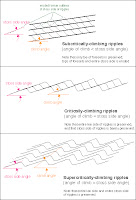Who said you could go on vacation...
 ...is what the grad-student-guilt angel is whispering in my ear on one shoulder. On the other shoulder is the holy-crap-you-deserve-a-break devil saying.....well, saying what he always says.
...is what the grad-student-guilt angel is whispering in my ear on one shoulder. On the other shoulder is the holy-crap-you-deserve-a-break devil saying.....well, saying what he always says.
I'm gonna actually listen to the devil for once. I will be away from the internets (and phones even!) until July 2nd. In the meantime, check out some of the blogtastic goodies out there:
- Where on (Google)Earth? 2.0: Ron and the Lab Lemming are taking my WoGE series to new levels. Posts are now coming from and being solved by more people. It is getting a little more geological instead of pure trivia (which is great). And we have plans to make it even better as time goes on. Check out my geoblogosphere ticker on the sidebar for the latest....or check out their blogs directly (links above) for the latest. Click here to see all the old WoGE 1.0 posts.
- I've been checking out some new blogs of late as well (new blogs to me, that is).
- I'm not sure what The Anterior Commissure is, but it has something to do with neuroscience. This blog has some great writing about an area of science I have little knowledge about. The author, Kate, explains things with the right combination of technical details (to help further my knowledge) and the important why-should-we-care rationale.
- At first this blog led to decreased productivity because I spent time reading it. But now, the topics on Academic Productivity are helping me think about how to manage the information that I collect and compile.
- Letter Never Sent is a potpourri of interesting writing and ideas. I especially like the post about simplifying your life.
- Tamino has teamed up with Maribo and Eli Rabbett for a new series of climate science posts. These are not new blogs individually, but the collaboration, or 'mob blogging' as they call it, is a new approach. The posts at Open Mind continue to impress me with the caliber of analysis and explanation of a complex system like climate. Check out one of the first posts of this series over at Rabbett Run dealing with the fundamentals of the carbon cycle.
- I've also been enjoying the TED talks. Every year in Monterey, CA a gathering of very sharp people (scientists, technologists, economists, social activists, artists, etc.) present talks about their ideas. Now you can view or download these talks at the TED website. They have everything from talking about reverse engineering the brain to the promise and perils of nanotechnology to beat poetry. It is a very slick site in terms of choosing from the database of talks based on topic tags. And they've made it very easy to download right to your video iPod, if you happen to have one. Great stuff...check it out.
See you in a couple weeks!
image above from here






















